Bit Generation Part 4: “The Birth of 16-Bit Gaming”
Bit Generation Series:
Fourth Generation (1987 – 1993)
“Birth of 16-bit Gaming”
PC Engine/TurboGrafx-16 (1987)
The TurboGrafx-16 Entertainment SuperSystem, known in Japan and France as the PC Engine is a home video game console jointly developed by Hudson Soft and NEC Home Electronics.
It was released firstly in Japan (1987) then US and France (1989) and finally UK and Spain (1990).
It was discontinued 1993 (Europe), 1994 (US/Japan).
During its lifetime it sold 5.8 million units worldwide and 3.9 million in Japan only.
Its power was due to the Hudson Soft HuC6280 CPU that could display resolutions up to 565×242 with 512 colours available (max 482 onscreen). Games were stored on a HuCard cartridge, or in CD-ROM optical format with the TurboGrafx-CD add-on.
Its release in the UK and Spain (1990) had it known simply TurboGrafx. It was the first console released in the 16-bit era, albeit still utilizing an 8-bit CPU. Originally intended to compete with the NES, it ended up competing with the Sega Genesis, and later on with the SNES.
Japan was its biggest success, where it gained strong third-party support and outsold the Famicom at its 1987 debut, eventually becoming the Super Famicom’s main rival. Lots of revisions – at least 17 distinct models – were made, such as portable versions and a CD-ROM add-on.
Hudsoft and NEC
It was a collaborative effort between Hudson Soft (game software creators) and NEC (a major company which was dominant in the Japanese personal computer market with their PC-88 and PC-98 platforms). NEC’s interest in entering the lucrative video game market coincided with Hudson’s failed attempt to sell designs for then-advanced graphics chips to Nintendo. As NEC lacked the vital experience in the video gaming industry they approached numerous video game studios for support. They eventually found that, by coincidence, Hudson Soft was also interested in creating their own system but needed a partner for additional cash. The two companies successfully joined together to then develop the new system.
Wanting to sell to the US market, they found the lack of enthusiasm in its name ‘PC Engine’. As a result they came up with the name ‘TurboGrafx-16’, a name representing its graphical speed and strength, and its 16-bit GPU. They also completely redesigned the hardware into a large, black casing. However the redesign took long, and NEC in Japan was still cautious about the system’s viability in the US, both of which delayed the system’s debut in the American market.
Eventually it was released in the New York City and Los Angeles test market in late August 1989. This came just two weeks after Sega’s Genesis test-market launch on 14th August, which was disastrous timing for NEC as Sega of America didn’t waste time redesigning the original Japanese Mega Drive system. The Genesis launch was accompanied by an ad campaign mocking NEC’s claim that the TurboGrafx-16 was the first 16-bit console. Initially, the TurboGrafx-16 was marketed as a direct competitor to the NES and early television ads touted the TG-16’s superior graphics and sound.
Sega quickly eclipsed the TurboGrafx-16 after its American debut and NEC decided to cancel their European releases. Units for the European markets were already produced, which were essentially US models modified to run on PAL television sets, and branded as simply TurboGrafx. NEC sold this stock to distributors – Telegames released the TurboGrafx in 1990 (UK) in extremely limited quantities. Although no PAL HuCards were made although the European system can play all American games without modifications, albeit with the necessary slow down to 50Hz.
PC Engine Duo
NEC claimed that it had sold 750,000 consoles in the US and 500,000 CD-ROM units worldwide (March 1991). That year NEC released the PC Engine Duo in Japan, a model which could play HuCards and CD-ROM discs, making it the first game console with an integrated CD-ROM drive.
It was licensed in the US by Turbo Technologies Incorporated who released it as the TurboDuo in 1992. In addition to standard CD-ROM format discs, the Duo could also play games in the newly introduced Super CD-ROM format due to its greater RAM size (the TurboGrafx-16 and its CD player could support this new format only through the use of a separately available upgrade, the Super System Card, which TTI sold via mail order).
This meant the unit came into direct competition with the Sega CD, which was released almost immediately after. Although the TurboDuo came with 5 bundled games, the Sega CD did not come with any and had to be purchased separately.
With the US console gaming market continued to be dominated by the Super NES and Genesis rather than the new CD-based consoles it was announced by Turbo Technologies that they would be dropping support for the duo in May 1994. It would continue to offer repairs for existing units and provide ongoing software releases through independent companies in the US and Canada.
The final commercialized release for the PC Engine was Dead of the Brain Part 1 & 2 on 3rd June 1999 (on the Super CD-ROM format). The last game on HuCard format was 21 Emon: Mezase! Hotel Ō on 16th December 1994.
Variations
Many variations and related products of the PC Engine were released.
PC-KD863G
This is a PC Engine built into a CRT monitor, released in Japan on 27th September 1988. It was designed to eliminate the need to buy a separate television set and a PC Engine console. It output its signals in RGB, so it was clearer at the time than the console which was still limited to RF and composite.
The Shuttle
Released in Japan on 22nd November 1989 as a cheaper version of the original PC Engine. It was completely redesigned into a larger case, making it incompatible with most PC Engine add-ons. It sold poorly and was discontinued within a year.
SuperGrafx
Released in Japan on 8th December 1989 and is an upgraded “true 16-bit” variation of the standard PC Engine hardware. This system is nearly identical except it has a second HuC6270A (VDC), a HuC6202 (VDP) to combine the output of the two VDCs, four times as much RAM, twice as much video RAM, and a second layer/plane of scrolling. The CPU, sound, and colour palette were not upgraded, making the expensive price tag a big disadvantage to the system. NEC also decided to not include the extra two video chips in the all-in-one Duo replacement system. Only five exclusive SuperGrafx games and two hybrid games (Darius Plus and Darius Alpha took advantage of the extra video hardware if played on a SuperGrafx) were released, and the system fell into obscurity.
CoreGrafx
An updated version of the PC Engine that was released in Japan on 8th December 1989(same day as the SuperGrafx). It was mostly identical to the original PC Engine but like the SuperGrafx it had a new black colour scheme, and it also replaced its RF connectors with an A/V port.
CoreGrafx II
The updated version was released in Japan on21st June 21 1991. This system had some cosmetic changes and a new colour scheme, but was again mostly identical to the original PC Engine.
PC Engine TurboExpress
This was a fully portable version of the console, and also had an optional TV tuner accessory.
PC Engine GT
This is another portable version of the TurboGrafx that was released in Japan on 1st December 1990 and in the US as the TurboExpress. It was the most advanced handheld of its time and could play all the TG-16’s HuCard games five years before the Genesis Nomad could do the same for Genesis cartridges. It has a 2.6-inch (66 mm) backlit, active-matrix colour LCD screen (the most advanced on the market for a portable video game unit at the time). The screen contributed to its high price and short battery life, however, which dented its performance in the market. It shares the capabilities of the TurboGrafx-16, giving it 512 available colours, stereo sound, and the same custom CPU at 7.15Mhz. It also had a TV tuner adapter as well as a two-player link cable.
PC Engine LT
This was released on 13th December 1991 (Japan) and the same day the Super CDROM system was released. It was essentially a PC Engine in a laptop form that does not require a television display as it has a built-in flip-up screen and speakers, but unlike the GT the LT runs on mains power supply. Its expensive price meant that it sold poorly, and it is a valuable collector’s item today.
CD-ROM System
The CD-ROM System is an add-on console that is attached to a standard TurboGrafx-16, which can play new CD-based format games as well as audio CDs. This made the PC Engine/TurboGrafx-16 the first video game console to have a CD-ROM peripheral, and first device ever to use CD-ROM as a storage medium for video games. Release in Jap (4th Dec 1988) and in the US (1st Aug 1990), it had a launch price of $399.99, and did not include any bundled games. Fighting Street and Monster Lair were the TurboGrafx-CD launch titles; Ys Book I & II soon followed.
NEC/Turbo Technologies later released the TurboDuo, which combined the TurboGrafx-CD and TurboGrafx-16 into one unit.
It was followed by the Super CD-ROM System format, which was released in Japan in 13th December 1991 as both: an add-on unit for the PC Engine with built-in BIOS, and as a Super System Card for the original CD-ROM System, which adds 192KB of RAM; required to play titles in Super CD-ROM format.
Certain games in Japan were released in a third disc format, the Arcade CD-ROM (released in Japan on 12th March 1994). It required the use of an Arcade Card which was available in a “Pro” version designed solely for the original CD-ROM System, and a “Duo” version that worked with the Super CD-ROM System and all PC Engine Duo models (both adding a total of 2MB of RAM). These are not compatible with the TurboGrafx-16, nor with the TurboDuo, without an adapter.
PE Engine Duo
NEC Home Electronics released the PC Engine Duo in Japan on 21st September 1991, which combined the PC Engine and the Super CD-ROM into a single unit. The system can play audio CDs, CD+Gs, CD-ROM and Super CD-ROM games as well as standard HuCards.
It was launched for the North American market as the TurboDuo in October 1992 and came bundled with one control pad, an AC adapter, RCA cables, Ys Book I & II (CD-ROM title), and a Super CD-ROM including Bonk’s Adventure, Bonk’s Revenge, Gate of Thunder and a secret version of Bomberman accessible via an easter egg.
The system was also packaged with one random HuCard game which varied from system to system (Dungeon Explorer was the original HuCard pack-in for TurboDuo, although many titles were eventually used, such as Irem’s Ninja Spirit and Namco’s Final Lap Twin, and then eventually a random pick).
The Super System Card required for Super CD-ROM format games when using the TurboGrafx-CD add-on was built into the Duo, rather than requiring the card to be inserted at all times when playing a Super CD title. Two updated variants were released in Japan: the Duo R (25th Mar 1993) and the Duo RX (25th Jun 1994).

Third-party models
The X1 Twin is a combination of X1 computer and PC Engine. It plays HuCards only. Pioneer Corporation’s LaserActive supports an add-on module which allows the use of PC Engine games (HuCard, CD-ROM and Super CD-ROM) as well as new “LD-ROM” titles that work only on this device. NEC also released their own LaserActive unit and PC Engine add-on module, under an OEM license. A total of eleven LD-ROM2 titles were produced, with only three of them released in the US.
The TurboGrafx-16 was released in South Korea by a third party under the name Vistar 16. It was based on the American version but with a new curved design. Various PC Engine Shuttle clones exist, with varying levels of compatibility with original PC Engine games. One of the more common types is the “PC Boy”. Although the PC Engine was never officially released in continental Europe, some companies imported them and made SCART conversions on a moderate scale.
Accessories
All PC Engine systems support the same controller peripherals, including pads, joysticks and multitaps. Except for the Vistar, Shuttle, GT, and systems with built-in CD-ROM drives, all PC Engine units shared the same expansion connector, which allowed for the use of devices such as the CD-ROM unit, battery backup and AV output.
The TurboGrafx and Vistar units use a different controller port than the PC Engines, but adaptors are available and the protocol is the same. The TurboGrafx offers the same expansion connector pinout as the PC Engine, but has a slightly different shape so peripherals must be modified to fit.
The TurboGrafx-16 had only one controller port, so any simultaneous multiplayer games required the TurboTap accessory.
The Arcade Card Pro is designed for the original CD-ROM System add-on, adding the 2304 kB of RAM required by Arcade CD-ROM games. The Arcade Card Duo is for the Super CD-ROM System and the PC-Engine Duo/R/RX consoles and adds 2048kB RAM, since those systems already have 256K of RAM built-in.
Video formats
All PC Engine hardware outputs video in NTSC format, including the European TurboGrafx; it generates a PAL-compatible video signal by using a chroma encoder chip not found in any other system in the series.
Legacy
In 1994, NEC released a new console, the Japan-only PC-FX, a 32-bit system with a tower-like design; it enjoyed a small but steady stream of games until 1998, when NEC finally abandoned the video games industry. NEC supplied rival Nintendo with the CPU for the Nintendo 64, released in 1996, and former rival Sega with a version of its PowerVR 2 GPU for the Dreamcast, released in 1998.
A number of TurboGrafx-16 and TurboGrafx-CD games were released on Nintendo’s Virtual Console download service for the Wii, Wii U, and Nintendo 3DS, including several that were originally never released outside Japan. In 2011, ten TurboGrafx-16 games were released on the PlayStation Network for play on the PS3 and PSP in the US region.
Finally in 2010, Hudson released an iPhone application entitled “TurboGrafx-16 GameBox” which allowed users to buy and play a number of select Turbo Grafx games via in-app purchases.
Sega Genesis/Mega Drive (1988)
Sega CD/Mega CD (1992), Sega 32X (1994)
Known as the Sega Genesis (US) and Mega Drive (Europe) was a 16-bit home video game console developed and sold by Sega Enterprises Ltd. It was released in 1988 (Jap) and 1989 (US/Europe).
It was distributed as the Mega Drive by Virgin Mastertronic in Europe, by Ozisoft in Australasia, and by Tectoy in Brazil. In South Korea, the systems were distributed by Samsung and were known as the Super Gam*Boy, and later the Super Aladdin Boy.
The hardware was based on the Motorola 68000 CPU (7.6Mhz, primary) and Zilog Z80 (3.58Mhz). It sold over 30 million during its lifetime and was discontinued in 1997 by Sega (1999 by Majesco Entertainment). It was capable of displaying 320×224 (NTSC) or 320×240(PAL) pixels using a 512 colour palette with 61 colours on-screen. Sound was taken care of by the Yamaha YM2612 / Texas Instruments SN76489 sound chip and it offered online services such as Sega Meganet, Sega Channel and XBAND.
It supports a library of more than 900 games created both by Sega and a wide array of third-party publishers and delivered on ROM-based cartridges. It can also play Master System games when the separately sold Power Base Converter was inserted.
Competition
In Japan, the Mega Drive did not fare well against its two main competitors, Nintendo’s Super Famicom and NEC’s PC Engine, but achieved considerable success in North America, Brazil and Europe. Contributing to its success were its library of arcade game ports, the popularity of the Genesis-exclusive Sonic the Hedgehog series, several popular sports game franchises, and aggressive youth marketing that positioned the system as the cool console for adolescents.
Many games have been re-released in compilations for newer consoles and offered for download on various online services, such as the Virtual Console, Xbox Live Arcade, PlayStation Network, and Steam. It was succeeded by the Sega Saturn.
Videogame Ratings
In 1993, the American media began to focus on the mature content of certain video games. Games such as Night Trap for the Sega CD, an add-on, received unprecedented scrutiny. Issues about Night Trap were brought up in the United Kingdom, with former Sega of Europe development director Mike Brogan noting that “Night Trap got Sega an awful lot of publicity … it was also cited in UK Parliament for being classified as “15” due to its use of real actors.”
This came at a time when Sega was capitalizing on its image as an edgy company with attitude, and this only reinforced that image. The most controversial title of the year by far was Midway’s Mortal Kombat, ported to the Genesis and SNES by Acclaim. In response to public outcry over the game’s graphic violence, Nintendo decided to replace the blood in the game with “sweat” and the arcade’s gruesome “fatalities” with less violent finishing moves although Sega took a very different approach, instituting America’s first video game ratings system, the Videogame Rating Council (VRC), for all its current systems. Ratings ranged from the family friendly GA rating to the more mature rating of MA-13, and the adults-only rating of MA-17. With the rating system in place, Sega released its version of Mortal Kombat, appearing to have removed all the blood and sweat effects and toning down the finishing moves even more than in the SNES version. However, all the arcade’s blood and uncensored finishing moves could be enabled by entering a “Blood Code”. This technicality allowed Sega to release the game with a relatively low MA-13 rating although a tamer SNES version shipped without a rating.
Add-ons
Sega released two add-ons to increase the consoles’ capabilities: a CD-based peripheral known as the Sega CD (1992) (Mega-CD outside North America), and a 32-bit peripheral known as the Sega 32X (1994). 2.24 million Sega CD units were sold worldwide with an estimated 665,000 32X units were sold by the end of 1994.
Sega underestimated the continued popularity of the Genesis and did not have the inventory to meet demand for the product although they were able to capture 43% of the dollar share of the US video game market and claimed to have sold more than 2 million Genesis units in 1995.
Nakayama decided then to focus on the Saturn over the Genesis, based on the systems’ relative performance in Japan. As a result, Nintendo took in 42% of the video game market dollar share, without launching a 32-bit console to compete directly with the PlayStation or the Saturn.
Following tensions with Sega Enterprises, Ltd. over its focus on the Saturn, Kalinske, who oversaw the rise of the Genesis in 1991, grew uninterested in the business and resigned in mid-1996.
Peripherals
Gamepads
The standard controller features a rounded shape, a directional pad, three main buttons, and a “start” button, a later release button in 1993 had Sega place six-buttons. This pad is slightly smaller and features three additional face buttons, similar to the design of buttons on some popular arcade fighting games such as Street Fighter II. The third model of the controller, MK-1470 was released with the Sega Genesis Model 3, with a switch between Normal, Turbo, and Slow while also having the Mode button. Sega released a wireless revision of the six-button controller, the Remote Arcade Pad.
Power Base Converter
The system is backward compatible with the Master System by means of a peripheral; the Power Base Converter (Master System Converter in Europe). This allows Master System games to be played. A second model, the Master System Converter 2, was released only in Europe for use with the Mega Drive II.
Light Gun
The Menacer is a wireless, infrared light gun peripheral used with compatible games. Other third parties created light gun peripherals for the Genesis, such as the American Laser Games Pistol and the Konami Justifier.
Mouse
Released for art creation software, the Sega Mega Mouse features three buttons and is only compatible with a few games, such as Eye of the Beholder.
Bat
A foam-covered bat called the BatterUP and the TeeVGolf golf club were released for both the Genesis and SNES.
Activator
In November 1993, Sega released the Sega Activator, an octagonal device that lies flat on the floor and translates the player’s physical movements into game inputs, well before the Nintendo Wii. Several high-profile games, including Mortal Kombat and Street Fighter II: Special Champion Edition, were adapted to support the peripheral. The device was a commercial failure, due mainly to its inaccuracy and its high price point.
Multitaps
Both EA and Sega released multitaps to allow more than the standard two players to play at once. Initially, EA’s version, the 4 Way Play, and Sega’s adapter, the Team Player, only supported each publisher’s titles.
Codemasters also developed the J-Cart system, providing two extra ports on the cartridge itself, although the technology came late in the console’s life and is only featured on a few games.
Steering Wheel
Sega planned to release a steering wheel peripheral in 1994, and the Genesis version of Virtua Racing was advertised as being “steering wheel compatible,” but the peripheral was cancelled.
Network services
The Sega Mega Modem peripheral allowed access to the Sega Meganet service. It was the foray into online gaming (17 games were available) debuted in Japan in 1990.
A US version dubbed “Tele-Genesis,” was announced but never released alongside another phone-based system, the Mega Anser; which turned the Japanese Mega Drive into an online banking terminal.
The Sega Channel was started in 1994 (by Sega) and was a game distribution system using cable television services Time Warner Cable and TCI. Using a special peripheral, Genesis players could download a title from a library of fifty each month, and demos for upcoming releases. Games were downloaded to internal memory and deleted when the console was powered off. The Sega Channel reached 250,000 subscribers at its peak and ran until 31st July 1998, well past the release of the Sega Saturn.
In an effort to compete with Sega, third-party developer Catapult Entertainment created the XBAND, a peripheral which allowed Genesis players to engage in online competitive gaming. Using telephone services to share data, XBAND was initially offered in five US. cities in November 1994. The following year, the service was extended to the SNES, and Catapult teamed up with Blockbuster Video to market the service, but as interest in the service waned, it was discontinued in April 1997.
Games
With the initial game library quite modest, this eventually grew to contain games to appeal to all types of players. The initial pack-in title was Altered Beast, which was later replaced with Sonic the Hedgehog (1991), with top sellers including Sonic the Hedgehog, its sequel Sonic the Hedgehog 2, and Disney’s Aladdin. When compared to its competition, Sega advertised to an older audience by hosting more mature games, including the uncensored version of Mortal Kombat.
As Sega was a prolific arcade developer in the 1980s, early Genesis games included arcade ports such as Altered Beast, Golden Axe, and Super Hang-On. Console teams would develop titles in acclaimed series such as Castle of Illusion, Phantasy Star, Shinobi, and Streets of Rage. Alex Kidd was the mascot of Sega’s previous console, but he would not receive any Mega Drive sequels after Alex Kidd in the Enchanted Castle due to Sega of America wanting to replace him with the titular character from Sonic the Hedgehog as mascot. The Sonic the Hedgehog series was a big hit both commercially and critically, with the original game being the best-selling game on the system.
In addition to games developed by Sega’s internal studios, Sega would collaborate with various other developers to publish more games for the system. These developers include Ancient (Beyond Oasis), BlueSky Software (Vectorman), Camelot (Shining Force), Climax Entertainment (Landstalker), Johnson Voorsanger Productions (ToeJam & Earl), Novotrade International (Ecco the Dolphin), Technopop (Zero Tolerance), Treasure (Gunstar Heroes), Vic Tokai (Decap Attack), and Virgin Games (Disney’s Aladdin).
Sega Virtua Processor
In order to produce more visually appealing graphics, companies began adding special processing chips to their cartridges to effectively increase the console’s capabilities. On the SNES, these are several DSP chips and RISC processors, which allow the console to produce faster and more accurate 3D and pseudo-3D graphics. In particular, the Super FX chip was designed to offload complex rendering tasks from the main CPU, enabling it to generate visual effects that the console cannot provide on its own. The chip was first used in Star Fox, which renders 3D polygons in real time, and Super Mario World 2: Yoshi’s Island demonstrated the ability to rotate, scale, and stretch individual sprites and manipulate large areas of the screen.
As these enhancements became more commonplace on the Super NES, the stock of existing Genesis games began to look outdated in comparison. Sega began work on an enhancement chip to compete with the Super FX, resulting in the Sega Virtua Processor. This chip enables the Genesis to render polygons in real time and provides an “Axis Transformation” unit that handles scaling and rotation. Virtua Racing, the only game released with this chip, runs at a significantly higher and more stable frame rate than similar games on the SNES. The chip was expensive to produce, and increased the cost of the games that used it (At $100; Virtua Racing was the most expensive Genesis cartridge ever produced). Two other games, Virtua Fighter and Daytona USA, were planned for the SVP chip, but were instead moved into the Saturn’s launch line-up. There were plans to sell the SVP chip as a separate upgrade module for the Genesis, but this module was never released.
Model Variations
More than a dozen licensed variations of the Sega Genesis/Mega Drive have been released in addition to models made by Sega, alternate models were made by other companies, such as Majesco Entertainment, AtGames, JVC, Pioneer Corporation, Amstrad, and Aiwa, alongside a number of bootleg clones were created during its lifespan.
Megadrive 2 (1993)
This was a smaller, lighter version of the console although omitted the headphone jack in the front, replaced the A/V-Out connector with a smaller version that supports stereo sound, and provides a simpler, less expensive mainboard that requires less power.
CDX
This was a combined, semi-portable Genesis/Sega CD unit (marketed as the Multi-Mega in Europe) that retailed for $399.95 (US) and was bundled with Sonic the Hedgehog CD, Sega Classics Arcade Collection and the Sega CD version of Ecco the Dolphin. It featured a small LCD screen that, when the unit is used to play audio CDs, displays the current track being played. With this feature and the system’s lightweight build (weighing two pounds), it was marketed it part as a portable CD player.
Nomad
Late in the 16-bit era, Sega released a handheld version of the Genesis called the Genesis Nomad. Its design was based on the Mega Jet, a Mega Drive portable unit featured on airplane flights in Japan. As the only successor to the Game Gear, the Nomad operates on 6x AA batteries, displaying its graphics on a 3.25-inch (8.25-mm) LCD screen. The Nomad supports the entire Genesis library, but cannot be used with the Sega 32X, the Sega CD, or the Power Base Converter.
Teradrive
Exclusive to the Japanese market was the TeraDrive, a Mega Drive combined with a computer. Sega produced three arcade system boards based on the Mega Drive: the System C-2, the MegaTech, and the MegaPlay, which support approximately 80 games combined.
Wondermega
JVC (working with Sega) released the Wondermega on 1st April 1992 (Japan). This was later redesigned by JVC and released as the X’Eye (US) in September 1994. Designed by JVC to be a Genesis and Sega CD combination with high quality audio, the Wondermega’s high price ($500 Launch) kept it out of the hands of average consumers.
The same was true of the Pioneer LaserActive, which requires an add-on known as the Mega-LD pack, developed by Sega, in order to play Genesis and Sega CD games. Although the LaserActive was lined up to compete with the 3DO Interactive Multiplayer, the combined price of the system and the Mega-LD pack made it a prohibitively expensive option for Sega players.
Aiwa released the CSD-GM1, a combination Genesis/Sega CD unit built into a boombox. Several companies added the Mega Drive to personal computers, mimicking the design of Sega’s TeraDrive; these include the MSX models AX-330 and AX-990, distributed in Kuwait and Yemen, and the Amstrad Mega PC, distributed in Europe and Australia.
After the Genesis was discontinued, Majesco Entertainment released the Genesis 3 as a budget version in 1998 and in 2009, AtGames began producing two new variations: the Firecore, which can play original Genesis cartridges as well as preloaded games, and a handheld console preloaded with 20 Genesis games. Companies such as Radica Games have released various compilations of Genesis and Mega Drive games in “plug-and-play” packages resembling the system’s controller.
PC Engine2/SuperGrafx (1989)
The PC Engine SuperGrafx, also shortened as the SuperGrafx or PC Engine SG, is a video game console by NEC Home Electronics, released exclusively in Japan. It is an upgraded version of the PC Engine, released two years prior. Like the PC Engine, the SuperGrafx was also imported and sold in France and Europe.
The machine was purported to be a true 16-bit system with improved graphics and audio capabilities over the original PC Engine. Expected to be released in 1990, the SuperGrafx was rushed to market, debuting several months earlier in late 1989 with only modest improvements over the original PC Engine. With only 7 games produced which took advantage of the improved SuperGrafx hardware (and two of those could be played on a regular PC Engine).
However, the SuperGrafx is backwards compatible with all PC Engine software in both, HuCard and CD-ROM format, bringing the compatible software total up to nearly 700. The system was not widely adopted and is largely seen as a commercial failure.
Hardware
When compared to the PC Engine, the Supergrafx has 4x the amount of working RAM for the main CPU and a second video chip with its own video RA, alongside a priority controller chip, which allows the output of both video chips to be combined in various ways. It also has support for two independently scrolling background layers (like the Mega Drive), as opposed to the PC Engine’s single layer.
Although despite having the same CPU as the PC Engine, the SuperGrafx is more than capable of keeping up with the new graphics enhancements, as the majority of the workload is handled by the VDPs.
One accessory of note was the “Power Console”, designed to add a full flight yoke, throttle and keypad to the SuperGrafx, sliding over the entire console. Besides a prototype, no Power Consoles were ever produced.
It was also backwards compatible with standard PC Engine HuCards in addition to its own. However, SuperGrafx-specific HuCards were expensive compared to standard HuCards, in some cases approaching as much as $110 more.
It is also compatible with the CD-ROM System add-on (via the ROM Adaptor), as well as the Super CD-ROM add-on; although no CD-ROM format games were produced that took advantage of the SuperGrafx’s added capabilities.
Under the hood is a 8-bit HuC6280A CPU (a modified 65SC02 running at 1.79, or 7.16 MHz which is switchable by the software). Features integrated bank-switching hardware (driving a 21-bit external address bus from a 6502-compatible 16-bit address bus), an integrated general-purpose I/O port, a timer, block transfer instructions, and dedicated move instructions for communicating with the HuC6270A VDC.
The GPU is a multiple graphics processor setup; 1x 16-bit HuC6260 Video Colour Encoder (VCE), 2x 16-bit HuC6270A Video Display Controllers (VDCs) and 1x HuC6202 Video Priority Controller.
Offering display resolutions of 565×242, although most developers at the time limited their games to either 256, 336, or 512 pixels in display width for each of the three modes.
Back this up with 32k RAM and 128k Video RAM (64k per HuC6270A VDC) with Six Wavetable Synthesis audio channels.
Peripherals
ROM Adaptor (RAU-30)
This was an adapter released in Japan on 20th April 1990 that allowed the SuperGrafx unit to be connected into CD-ROM System’s Interface Unit. This was not required for the later Super CD-ROM System add-on.
Power Console (PI-PD7)
An unreleased cockpit-sized controller that attaches onto the SuperGraph unit itself, connecting via the expansion port on the front side. The peripheral would’ve added numerous control options such as an eight-way joystick, four action buttons, a flight yoke with two triggers (one on each handle), a throttle lever, a jog dial, three mode switches, an LCD panel, an LED indicator, four additional controller ports and a numerical keypad. The Power Console was scheduled to be released in Spring 1990 but was never released due to its high production cost and the poor sales of the SuperGrafx itself.
The SuperGrafx is compatible with all standard PC Engine input devices, such as the TurboPad and the Multitap.
Games
All SuperGrafx releases were on the HuCard format.
‘PC-SG’ HuCards were designed to take advantage of the PC Engine SuperGrafx’s enhanced capabilities, but were otherwise forward compatible with standard PC Engine consoles.
Unreleased Games
Forgotten Worlds – Announced only although eventually released in Super CD-ROM format.
Galaxy Force II
Strider Hiryu – Announced only although eventually released in Super CD-ROM format.
Neo-Geo (1990) / Neo-Geo CD (1994)
The Neo Geo is a cartridge-based arcade system console released on 26th April 1990, by Japanese game company SNK Corporation. It was the first system in SNK’s Neo Geo family. The Neo Geo was marketed as 24-bit; its CPU is technically a parallel processing 16/32-bit 68000-based system with an 8/16-bit Z80 coprocessor much like the Sega Genesis and the Super NES, while its GPU chipset has a 24-bit graphics data bus.
It was originally launched as the MVS (Multi Video System) coin-operated arcade machine. The MVS offers owners the ability to put up to six different cartridges into a single cabinet, a unique feature that was also a key economic consideration for operators with limited floor space, as well as saving money in the long-run. With its games stored on self-contained cartridges, a game cabinet can be exchanged for a different game title by swapping the game’s ROM Cartridge and cabinet artwork. A home console version was also made, called AES (Advanced Entertainment System) that was originally launched as a rental console for video game stores in Japan (called Neo Geo Rental System), although with its high price causing SNK not to release it for home use – this was later reversed due to high demand and it came into the market as a luxury console.
The AES had the same raw specs as the MVS and had full compatibility, thus managed to bring a true arcade experience to home users. As of 2013 it was the most expensive home video game console ever released ($1,125). The Neo Geo was revived along with the brand overall in December 2012 through the introduction of the Neo Geo X handheld and home system.
It is powered by the Motorola 6800 (12Mhz) and Zilog Z80 (4Mhz), along with 64k RAM, 84k VRAM and 2k Sound RAM. It was capable of displaying 320×224 resolutions with 4,096 on-screen colours out of a palette of 65,536. Sound was taken care of by the Yahama YM2610 Chip.
It was finally discontinued in 1997 (hardware), 2004 (software) and 2007 (technical support).
History
It’s hardware was a direct evolution of an older SNK/Alpha Denshi M68000 arcade platform that was used in Time Soldiers (1987). This was further developed in the SNK M68000 hardware platform as used for POW: Prisoners of War (1988). Contrary to other popular arcade hardware of the time, the SNK/Alpha Denshi hardware used sprite strips instead of the more common tile-map based backgrounds.
The Neo Geo hardware was essentially developed by Alpha Denshi’s Eiji Fukatsu, adding sprite scaling through the use of scaling tables stored in ROM as well as support for a much higher amount of data on cartridges and better sound hardware.
The Neo Geo was announced on 31st January 1990 (Osaka, Japan) and released on 26th April 1990. Initially, the AES home system was only available for rent to commercial establishments, such as hotel chains, bars and restaurants, and other venues. When customer response indicated that some gamers were willing to buy a $650 console, SNK expanded sales and marketing into the home console market in 1991.
The US debut price was planned to be $599 which included two joystick controllers and a game: either Baseball Stars Professional or NAM-1975. However, the price was raised and its US launch debuted as the Gold System at $649.99. Later, the Gold System was bundled with Magician Lord and Fatal Fury alongside The Silver System package, launching at $399.99, that included only one joystick controller but no game. Other games were launched at about $200 and up. At double or quadruple the competition, these premium prices made the console accessible only to a niche market.
Neo-Geo CD (1994)
With real-time 3D graphics becoming the norm in the arcade industry, the Neo Geo’s 2D hardware was unable to do likewise. Despite this, Neo Geo arcade games retained profitability through the mid-1990s and the system was one of three 1995 recipients of the American Amusement Machine Association’s Diamond Awards (which are based strictly on sales achievements).
SNK developed a new console on 9th September 1994, called the Neo Geo CD. A new arcade was also made in 1997, called Hyper Neo Geo 64. However these two systems had low popularity and only a few games. It is basically the same platform, converted to the cheaper CD format retailing at $49 to $79 per title, compared to the $300 cartridges. Originally priced at $399 (US) / £399 (UK), the unit’s 1X CD-ROM drive was very slow, with long loading times of up to 56 Mbit of data per load. Although the system could also play Audio CDs, all three versions of the system have no region-lock. The Neo Geo CD was launched bundled with a control pad instead of a joystick like the AES version. However, the original AES joystick can be used with all three Neo Geo CD models.
As of March 1997, the Neo Geo CD had sold 570,000 units worldwide.
The specification was that of the main CPU being the Motorola 68000 (12Mhz). Although there are some clones that run the Toshiba TMP68HC000 CPU. It also had a secondary CPU (Zilog Z80 4Mhz).
In addition to the multi-AV port (almost same one as used on the Sega Genesis model 1, though they are not interchangeable), all Neo Geo CD models had composite RCA A/V and S-Video out jacks on the rear of the console.
Games
While the Neo Geo CD library consists primarily of ports of MVS and AES titles, there are a few MVS arcade games which were not officially released for the Neo Geo AES and ported instead to the Neo Geo CD. These include Puzzle Bobble, Janshin Densetsu: Quest of Jongmaster (a Mahjong game also released for the PC Engine), Power Spikes II, Neo Drift Out: New Technology, and Pleasure Goal: 5-on-5 Mini Soccer (Futsal: 5-on-5 Mini Soccer).
A few games which were unreleased in MVS and AES formats were also released exclusively for the Neo Geo CD. These include Ironclad: Tesshō Rusha (Chōtetsu Burikingā, BRIKIN’GER), Crossed Swords II, ZinTrick (Oshidashi Zintorikku), ADK World, Neo Geo CD Special, The King of Fighters ’96 Neo Collection, Samurai Shodown RPG (Shinsetsu Samurai Spirits: Bushidō Retsuden; an RPG spin-off of the Samurai Shodown series that was also released for the Sony PlayStation and Sega Saturn), and Idol-Mahjong Final Romance 2 (an arcade game which is not an MVS game, but was ported directly to the Neo Geo CD).
Despite the failures of these 3D hardware machines (and the ceasing of manufacturing home consoles by the end of 1997), SNK continued making software for the original 2D Neo Geo with popular releases such as The King of Fighters 2002. The last official game by SNK for the Neo Geo system, Samurai Shodown V Special, was released in 2004, 14 years after the system’s introduction.
Although on 31st August 2007, SNK stopped offering maintenance and repairs to Neo Geo home consoles, handhelds, and games.
Neo Geo X (2012)
The Neo Geo X, an officially licensed device with a collection of Neo Geo games pre-installed, was first released in 2012. It was discontinued by 2017, after a somewhat ‘lukewarm’ reception.
ROM sizes and start-up screens
The original ROM size is up to 330 megabits, hence the system displaying “MAX 330 MEGA PRO-GEAR SPEC” upon startup. While no technical advances were required to achieve it, some games over 100 megabits, such as Top Hunter, followed this screen by displaying an animation proclaiming “THE 100MEGA SHOCK!”. The original ROM size specification was later enhanced on cartridges with bank switching memory technology, increasing the maximum cartridge size to around 716 megabits. These new cartridges also cause the system to display “GIGA POWER PRO-GEAR SPEC” upon startup or during attract mode, indicating this enhancement.
GameTap Service
This subscription service included a Neo Geo emulator and a small library of Neo Geo games. In 2007 Nintendo announced that Neo Geo games would appear on the Wii’s Virtual Console, starting with Fatal Fury: King of Fighters, Art of Fighting, and World Heroes. Neo Geo games were released through Xbox Live Arcade and PlayStation Network, including Fatal Fury Special, Samurai Shodown II, Metal Slug 3, Garou: Mark of the Wolves and The King of Fighters ’98. Alongside many other games released on the PlayStation 4, Xbox One, and Nintendo Switch through the Arcade Collection Archives (ACA) service.
Neo Geo has a community of collectors. Because of the limited production runs received by cartridges amongst the sizable available arcade library, some of the rarest Neo Geo games can sell for well over $1,000. The most valuable game is the European AES version of Kizuna Encounter. The MVS market provides a cheaper alternative to the expensive and rare home cartridges, and complete arcade kits are priced at a premium. It is also possible to play the MVS cartridges, which generally cost much less, on the AES home system through the use of adapters.
Amstrad GX4000 (1990)
Manufactured by Amstrad it was the company’s short-lived attempt to enter the games console market in 1990 (Europe). It was an upgraded design based on the then still-popular CPC technology although shared its hardware architecture with Amstrad’s CPC Plus computer line, which was released concurrently (August 1990). This allowed the system to be compatible with the majority of CPC Plus software. It launched with a retail price of £99.99 (UK) with software priced at around £25. The racing game Burnin’ Rubber, a power pack and two controllers were bundled with the machine.
It is considered a 3rd generation computer rather than 4th although the release time line fits it into the 4th generation. It ran its software from a rom based cartridge powered by the Zilog Z80 (4Mhz).
The GX4000 was not successful commercially due to having sold only 15,000 units in total and discontinued in 1991. During its life consumer interest was low, and coverage from popular magazines of the time was slight, with some readers complaining about a lack of information regarding the machine (Amstrad Action was one of the few magazines to support the console). Within a few weeks of the initial launch, the system could be bought at discounted prices, and by July 1991 some stores were selling it for as little as £29.99
Peripherals
GX4000 Controller
This is similar to popular 8-bit gamepads of the time such as those for the Master System and NES, as well as that for the TurboGrafx-16. It contains only two buttons on the actual pad with the pause button located on the console itself, and uses the prevailing de facto standard Atari-style 9-pin connector.
Analog Joysticks
The GX4000 supports the use of analog controllers through its specific IBM standard analog controller port. The controller was not widely supported by software though.
Lightguns
Supporting the of a light gun through its dedicated RJ11 light gun connector. Multiple 3rd party Light guns were available, and official releases supported this peripheral. There were however only two games supporting the use of a light gun – Skeet Shoot and The Enforcer which were both distributed with a 3rd party gun.
Games
In all, 27 games were produced and distributed for the GX4000. The majority of games were made by UK- and French-based companies such as Ocean, Titus, and Loriciels.
Notable games were the pack-in game: Burnin’ Rubber as well as RoboCop 2, Pang, Plotting, Navy Seals and Switchblade. Although many more games were initially announced (Toki, Kick Off 2, Outrun), but were later cancelled when the system failed to sell.
C64 Game System (C64GS) (1990)
Another machine that is very much considered a 3rd generation computer rather than 4th although the release time line fits it into the 4th generation.
Released by Commodore in December 1991 (Europe only) into a booming console market dominated by Nintendo and Sega. It came bundled with a cartridge that featured four games: Fiendish Freddy’s Big Top O’Fun, International Soccer, Flimbo’s Quest and Klax.
The C64GS was not Commodore’s first gaming system based on the C64 hardware. However, unlike the 1982 MAX Machine (a game-oriented computer based on a very cut-down version of the same hardware family), the C64GS is internally very similar to the complete C64, with which it is compatible, albeit no keyboard (which is required for most C64 games in some form).
It utilises the MOS 8500 CPU under its hood (the 6510/8500 being a modified 6502 with an integrated 6-bit I/O port) which ran a clock speed of 0.985 MHz (PAL) alongside 64k RAM (0.5k Colour RAM) and 20k ROM. The ROM contained two important differences from a standard C64 ROM. The first is that switching on the machine without a cartridge present results in a character-based animation asking the user to insert a cartridge. The second is an additional set of windowing commands, designed to compensate for the lack of a keyboard. However, there is no known software that uses it.
Graphics were taken care of with the MOS VIC-II MOS 8569 (PAL) CPU allowing for 16 colours over 320×200 (160×200) bitmap modes. Sound hardware was that of the MOS 8580 “SID” chip that many C64 owners are familiar with allowing for 3 voices, ADSR programmable, 4 Waveforms, Oscillator Synchronization, Ring modulation and Programmable Filters.
I/O ports were that of High-quality Y/C (S-Video) (8-pin DIN plug) with chroma/luma out and sound in + out, used with some Commodore video monitors and Composite video (one-signal video output to monitor included in aforementioned 8-pin DIN plug, and separate integrated RF modulator antenna output, which also carries sound, to TV on an RCA socket).
Game controller ports (DE9M) with a cartridge slot (44-pin slot for edge connector with 6510 CPU address/data bus lines and control signals, as well as GND and voltage pins; used for program modules) where the main gaming parts of the machine.
Third Party Support
Support from games companies was limited, as many were unconvinced that the C64GS would be a success in the console market. Ocean Software was the most supportive, offering a wide range of titles, some C64GS cartridge-based only, offering features in games that would have been impossible on cassette-based games, others straight ports of games for the original C64. Domark and System 3 also released a number of titles for the system, and conversions of some Codemasters and MicroProse games also appeared. Denton Designs also released some games, among them Bounces, which was released in 1985.
Ocean produced a number of games for the C64GS, among them a remake of Double Dragon (which seemed to be more linked to the NES version than the original C64 cassette version), Navy SEALS, Robocop 2, Robocop 3, Chase HQ 2: Special Criminal Investigation, Pang, Battle Command, Toki, Shadow of the Beast and Lemmings. They also produced Batman: The Movie for the console, but this was a direct conversion of the cassette game, evidenced by the screens prompting the player to “press PLAY” that briefly appeared between levels. Some of the earliest Ocean cartridges had a manufacturing flaw, where the connector was placed too far back in the cartridge case. The end result was that the cartridge could not be used with the standard C64 computer. Members of Ocean staff had to manually drill holes in the side of the cartridges to make them fit.
System 3 released Last Ninja Remix and Myth: History in the Making, although both were also available on cassette. Domark also offered two titles, Badlands and Cyberball, which were available on cartridge only.
Through publisher The Disc Company, a number of Codemasters and MicroProse titles were also reworked and released as compilations for the C64GS. Fun Play featured three Codemasters titles: Fast Food, Professional Skateboard Simulator and Professional Tennis Simulator. Power Play featured three MicroProse titles: Rick Dangerous, Stunt Car Racer and MicroProse Soccer, although Rick Dangerous was produced by Core Design, not MicroProse themselves. Stunt Car Racer and MicroProse Soccer needed to be heavily modified to enable them to run on the C64GS.
Commodore never produced or published a single title for the C64GS beyond the bundled four-game cartridge. International Soccer was the only widely available game for the C64GS but had actually been written for the C64.
Hardware Problems
The C64GS has been plagued with problems from the outset. Firstly, despite the wealth of software already available on cartridge for C64, the lack of a keyboard means that most cannot be used with the console. This means that people had often bought 2nd hand C64 software on cartridge only to find that the games are not compatible. The standard C64 version of Terminator 2: Judgment Day was designed for the console, but was included on a cartridge that required the user to press a key to access the game, rendering it unplayable on the C64GS.
To partially counter the lack of a keyboard, the basic control system for the C64GS was a joystick supplied by Cheetah called the Annihilator. This joystick, while using the standard Atari 9-pin plug, offers two independent buttons, with the second button located on the base of the joystick. This 9-pin plug was standard of many systems of the era, and the joysticks are fundamentally compatible with the ZX Spectrum’s Kempston Interface and the Sega Master System. The Cheetah Annihilator joystick was poorly built, had a short life, and was not widely available, making replacements difficult to come by.
Primary reasons for failure
Prior to the console’s release, Commodore had generated a great deal of marketing hype to generate interest in an already crowded market. Zzap! 64 and Your Commodore had reported that Commodore had promised “up to 100 titles before December” (December was two months from the time of its writing). In reality only 28 games were produced for the console during its shelf life – most of which were compilations of older titles, and a majority of which were from Ocean. Of those 28 titles, only 9 were cartridge-exclusive titles, the remainder being ports of older cassette-based games.
While most of the titles that Ocean announced did appear for the GS (with the notable exception of Operation Thunderbolt), a number of promises from other publishers failed to materialize. Although Thalamus, The Sales Curve, Mirrorsoft and Hewson had expressed an interest, nothing ever materialized from these firms. Similar problems plagued rival company Amstrad when they released their GX4000 console the same year.
The C64GS was essentially a cut-back version of the original Commodore 64, and the games developed for it could also be run on the original computer. The C64 was already at an affordable price, and the C64GS was sold for the same. People preferred the original C64, particularly since the cassette versions of games could often be picked up for a fraction of the cost of the cartridge versions.
Super NES/Super Famicom (1990) + SNES-CD (Cancelled)
The Super Nintendo Entertainment System (Super NES or SNES is a 16-bit home video game console developed by Nintendo and released Japan and South Korea (1990), US (1991), Europe and Australasia (1992) and Brazil (1992). It had an introductory price of $199 and sold 49.1 units worldwide (US 23.3, Jap 17.7). It was powered by the Ricoh 5A22 (3.58Mhz) CPU and Nintendo S-SMP Sound.
The 16-bit design of the SNES incorporates graphics and sound co-processors that allow tiling and simulated 3D effects, a palette of 32,768 colours, and 8-channel ADPCM audio.
On a physical level, the cartridges are shaped differently for different regions. US cartridges have a rectangular bottom with inset grooves matching protruding tabs in the console, while other regions’ cartridges are narrower with a smooth curve on the front and no grooves. The physical incompatibility can be overcome with use of various adapters, or through modification of the console.
Internally, a regional lockout chip (CIC) within the console and in each cartridge prevents PAL region games from being played on Japanese or US consoles and vice versa (The Japanese and US machines have the same region chip). This can be overcome through the use of adapters, typically by inserting the imported cartridge in one slot and a cartridge with the correct region chip in a second slot. Alternatively, disconnecting one pin of the console’s lockout chip will prevent it from locking the console; hardware in later games can detect this situation, so it later became common to install a switch to reconnect the lockout chip as needed.
PAL consoles face another incompatibility when playing out-of-region cartridges: the NTSC video standard specifies video at 60 Hz while PAL operates at 50 Hz, resulting in approximately 16.7% slower framerate. Additionally, PAL’s higher resolution results in letterboxing of the output image. Some commercial PAL region releases exhibit this same problem and, therefore, can be played in NTSC systems without issue while others will face a 20% speedup if played in an NTSC console. To mostly correct this issue, a switch can be added to place the SNES PPU into a 60 Hz mode supported by most newer PAL televisions. Later games will detect this setting and refuse to run, requiring the switch to be thrown only after the check completes.
All versions of the SNES are predominantly gray, although the exact shade may differ. The original US version (designed by Nintendo of America industrial designer Lance Barr, who previously redesigned the Famicom to become the NES), has a boxy design with purple sliding switches and a dark gray eject lever. The loading bay surface is curved, both to invite interaction and to prevent food or drinks from being placed on the console and spilling as had happened with the flat surfaced NES.
The Japanese and European versions are more rounded, with darker gray accents and buttons. The US SNS-101 model and the Japanese Super Famicom Jr. (the SHVC-101 model), all designed by Barr, are both smaller with a rounded contour; however, the SNS-101 buttons are purple where the Super Famicom Jr. buttons are gray. The European and US versions of the SNES controllers have much longer cables compared to the Japanese Super Famicom controllers.
All versions incorporate a top-loading slot for game cartridges, although the shape of the slot differs between regions to match the different shapes of the cartridges. The MULTI OUT connector (later used on the Nintendo 64 and GameCube) can output composite video, S-Video and RGB signals, as well as RF with an external RF modulator. Original versions additionally include a 28-pin expansion port under a small cover on the bottom of the unit and a standard RF output with channel selection switch on the back;[62] the redesigned models output composite video only, requiring an external modulator for RF.
In Japan, the system is called the Super Famicom (designed by Masayuki Uemura), officially adopting the abbreviated name of its predecessor, the Famicom; or SFC for short. In South Korea, it is known as the Super Comboy and was distributed by Hyundai Electronics. Although each version is essentially the same, several forms of regional lockout prevent the different versions from being compatible with one another.
To compete with the popular Family Computer in Japan, NEC Home Electronics launched the PC Engine in 1987, and Sega Enterprises followed suit with the Mega Drive in 1988. The two platforms were later launched in North America in 1989 as the TurboGrafx-16 and the Genesis respectively. Both systems were built on 16-bit architectures and offered improved graphics and sound over the 8-bit NES. However, it took several years for Sega’s system to become successful. Nintendo executives were in no rush to design a new system, but they reconsidered when they began to see their dominance in the market slipping.
The four colour Super Famicom mark is part of the Super NES logo in the PAL region. The colors correspond to those of the ABXY buttons of the control pad in those regions. A different logo was used for the North American version (right), consisting of a striped background outlining four oval shapes.
Nintendo’s initial shipment of 300,000 units sold out within hours, and the resulting social disturbance led the Japanese government to ask video game manufacturers to schedule future console releases on weekends. Its release also gained the attention of the Yakuza, leading to a decision to ship the devices at night to avoid robbery. With the Super Famicom quickly outselling its chief rivals, Nintendo reasserted itself as the leader of the Japanese console market.
Nintendo released the Super Nintendo Entertainment System, a redesigned version of the Super Famicom (US $199). It began shipping in limited quantities on 23rd August 1991; with an official nationwide release date of 9th September 1991. It was released in the UK and Ireland in April 1992 for £150, with a German release following a few weeks later.
Most of the PAL region versions of the console use the Japanese Super Famicom design, except for labelling and the length of the joypad leads. The Playtronic Super NES in Brazil (although PAL), uses the North American design. With both the NES and SNES released in Brazil in 1993 by Playtronic, a joint venture between the toy company Estrela and consumer electronics company Gradiente.
Launch Games
In Japan, only two games were initially available: Super Mario World and F-Zero. The US had Super Mario World launched as a bundle with the console, and other launch titles include F-Zero, Pilotwings (both of which demonstrated the console’s “Mode 7” pseudo-3D rendering capability), SimCity, and Gradius III.
Console Wars
The rivalry between Nintendo and Sega resulted in what has been described as one of the most notable console wars in video game history, in which Sega positioned the Genesis/Megadrive as the “cool” console, with more mature titles aimed at older gamers, and edgy advertisements that occasionally attacked the competition.
Nintendo however, scored an early public relations advantage by securing the first console conversion of Capcom’s arcade classic Street Fighter II (SNES), which took over a year to make the transition to the Genesis. Despite its head start, much larger library of games, and lower price point, it represented about 60% of the American 16-bit console market in June 1992. With Donkey Kong Country having said to have helped establish the SNES’s market prominence in the latter years of the 16-bit generation, and for a time, maintain against the PlayStation and Saturn.
32-bit era and beyond
While other companies were moving on to 32-bit systems, Rare and Nintendo proved that the SNES was still a strong contender in the market; Rare released Donkey Kong Country (Nov 1994), a platform game featuring 3D models and textures pre-rendered on SGI workstations. With its detailed graphics, fluid animation and high-quality music, Donkey Kong Country rivalled the aesthetic quality of games that were being released on newer 32-bit CD-based consoles. In the last 45 days of 1994, the game sold 6.1 million units, making it the fastest-selling video game in history to that date. This game sent a message that early 32-bit systems had little to offer over the SNES, and helped make way for the more advanced consoles on the horizon.
In October 1997, Nintendo released a redesigned model of the SNES (the SNS-101 model referenced by Nintendo as “New-Style Super NES”) in the US for $99, with some units including the pack-in game Super Mario World 2: Yoshi’s Island. Like the earlier redesign of the NES (the NES-101 model), the new model was slimmer and lighter than its predecessor, but it lacked S-Video and RGB output, and it was among the last major SNES-related releases in the region. A similarly redesigned Super Famicom Jr. was released in Japan at around the same time.
Nintendo ceased production of the SNES in 1999 (about two years after releasing Kirby’s Dream Land 3). Although in Japan, Nintendo continued production of the Super Famicom until 25th September 2003 and new games were produced until the year 2000, ending with the release of Metal Slader Glory Director’s Cut on 29th November 2000.
Game Boy Advance
Many popular SNES titles have since been ported to the Game Boy Advance, which has similar video capabilities. In 2005, Nintendo announced that SNES titles would be made available for download via the Wii and Wii U’s Virtual Console service and on 31st October 2007, Nintendo announced that it would no longer repairing Family Computer or Super Famicom systems due to an increasing shortage of the necessary parts.
Peripherals
The standard SNES controller adds two additional face buttons (X and Y) to the design of the NES iteration, arranging the four in a diamond shape, and also introduces two shoulder buttons. It features an ergonomic design by Lance Barr, later used for the NES-102 model controllers.
The Japanese and PAL region versions incorporate the colours of the four action buttons into system’s logo. The US version’s buttons are coloured to match the redesigned console; the X and Y buttons are lavender with concave faces, and the A and B buttons are purple with convex faces. Several later consoles derive elements of their controller design from the SNES, including the PlayStation, Dreamcast, Xbox, and Wii Classic Controller.
Throughout the course of its life, a number of peripherals were released which added to the functionality of the SNES. Many of these devices were modelled after earlier add-ons for the NES: the Super Scope is a light gun functionally similar to the NES Zapper (though the Super Scope features wireless capabilities) and the Super Advantage is an arcade-style joystick with adjustable turbo settings akin to the NES Advantage. Nintendo also released the SNES Mouse in conjunction with its Mario Paint title. Hudson Soft, under license from Nintendo, released the Super Multitap, a multiplayer adapter for use with its popular series of Bomberman games. Some of the more unusual controllers include the BatterUP baseball bat, the Life Fitness Entertainment System (an exercise bike controller with built-in monitoring software) and the TeeV Golf golf club.
The Super Game Boy allowed Game Boy games to be played on the SNES.
Satellaview
Japan saw the release of the Satellaview, a modem which attached to the Super Famicom’s expansion port and connected to the St.GIGA satellite radio station. Users of the Satellaview could download gaming news and specially designed games, which were frequently either remakes of or sequels to older Famicom titles, released in installments. Satellaview signals were broadcast from 23rd April 1995 through 30th June 2000. In the US, the similar but relatively short-lived XBAND allowed users to connect to a network via a dial-up modem to compete against other players around the country.
Enhancement chips
Star Fox, the first game to utilize the Super FX chip, as shown with the polygonal models that compose a large portion of the game’s graphics. As part of the overall plan for the SNES, rather than include an expensive CPU that would still become obsolete in a few years, the hardware designers made it easy to interface special coprocessor chips to the console (just like the MMC chips used for most NES games). This is most often characterized by 16 additional pins on the cartridge card edge.
The Super FX is a RISC CPU designed to perform functions that the main CPU could not feasibly do. The chip was primarily used to create 3D game worlds made with polygons, texture mapping and light source shading. The chip could also be used to enhance 2D games.
The Nintendo fixed-point digital signal processor (DSP) chip allowed for fast vector-based calculations, bitmap conversions, both 2D and 3D coordinate transformations, and other functions. Four revisions of the chip exist, each physically identical but with different microcode. The DSP-1 version, including the later 1A and 1B bug fix revisions, is used most often; the DSP-2, DSP-3, and DSP-4 are used in only one title each.
Similar to the 5A22 CPU in the console, the SA-1 chip contains a 65c816 processor core clocked at 10 MHz, a memory mapper, DMA, decompression and bitplane conversion circuitry, several programmable timers, and CIC region lockout functionality.
SNES Emulation
Emulation projects began with the initial release of VSMC in 1994, and Super Pasofami became the first working SNES emulator in 1996. During that time, two competing emulation projects—Snes96 and Snes97—merged to form a new initiative titled Snes9x. Then in 1997; SNES enthusiasts began programming an emulator named ZSNES. In 2004, higan began development as Bsnes, in an effort to emulate the system as closely as possible.
Nintendo of America took the same stance against the distribution of SNES ROM image files and the use of emulators as it did with the NES, insisting that they represented flagrant software piracy. Proponents of SNES emulation cite discontinued production of the SNES constituting abandonware status, the right of the owner of the respective game to make a personal backup via devices such as the Retrode, space shifting for private use, the desire to develop homebrew games for the system, the frailty of SNES ROM cartridges and consoles, and the lack of certain foreign imports.
SNES CD
During the SNES’s life, Nintendo contracted with two different companies to develop a CD-ROM-based peripheral for the console to compete with Sega’s CD-ROM based add-on, Sega CD. Ultimately, deals with both Sony and Philips fell through, (although a prototype console was produced by Sony) with Philips gaining the right to release a series of titles based on Nintendo franchises for its CD-i multimedia player and Sony going on to develop its own console based on its initial dealings with Nintendo (the PlayStation).
The relationship between Sony and Nintendo started when Sony engineer Ken Kutaragi became interested in working with video games after seeing his daughter play games on Nintendo’s Famicom video game console. He took on a contract at Sony for developing hardware that would drive the audio subsystem of Nintendo’s next console, the Super NES. Kutaragi secretly developed the chip, known as the Sony SPC 700. As Sony was uninterested in the video game business, most of his superiors did not approve of the project, but Kutaragi found support in Sony executive Norio Ohga and the project was allowed to continue. The success of the project spurred Nintendo to enter into a partnership with Sony to develop both a CD-ROM add-on for the Super NES and a Sony-branded console that would play both SNES games, as well as titles released for the new SNES-CD format.
Development of the format started in 1988, when Nintendo signed a contract with Sony to produce a CD-ROM add-on for the SNES. After several years of development, Sony introduced a standalone console at 1991’s summer Consumer Electronics Show called the “Play Station.” The system was to be compatible with existing SNES titles as well as titles released for the SNES-CD format. However, due to licensing disagreements with Sony, Nintendo announced that it had formed an alliance with Sony’s rival Philips to produce the SNES-CD add-on.
Under their agreement, Sony would develop and retain control over the SNES-CD disc format, with Nintendo thus effectively ceding a large amount of control of software licensing to Sony. To counter this, Nintendo president Hiroshi Yamauchi sent Nintendo of America President Minoru Arakawa and executive Howard Lincoln to Europe to negotiate a more favourable contract with Philips, Sony’s industry rival. At the June 1991 Consumer Electronics Show, Sony announced its SNES-compatible cartridge/CD console, the “Play Station”. The next day, Nintendo revealed its partnership with Philips at the show—a surprise to the entire audience, including Sony.
In November 2015, it was reported that one of the original Nintendo PlayStation prototypes had been found. The prototype was reportedly left behind by former Sony Interactive Entertainment CEO Ólafur Jóhann Ólafsson during his time at Advanta. A former Advanta worker (Terry Diebold) acquired the device as part of a lot during Advanta’s 2009 bankruptcy auction. The system was later confirmed as operational and the unit plays Super Famicom cartridges as well the test cartridge that accompanied the unit, although the audio output and CD drive were non-functional. In March 2016, retro-gaming website RetroCollect reported that they (and influential members of online emulation communities) had received (from an anonymous source) a functional disc boot ROM for the SNES-CD.
In July 2016, a homebrew game titled Super Boss Gaiden was developed for the add-on and later that month, Benjamin Heckendorn, in his YouTube channel, “The Ben Heck Show”, posted a teardown of the device and repaired the CD-ROM drive to the point of getting CD audio output, but games could only be played from the top cartridge slot. Then on 5th May 2017, Heckendorn published a video of a functional version of the console in his channel, where he described the procedure by which he repaired it, and played a couple of homebrew games from the console’s CDROM drive.
The standalone unit has the following connectors: Two SNES Gamepad ports, Cartridge slot, Dual-speed CD-ROM, AV RCA composite Stereo, S-Video, RFU DC OUT (similar to the PlayStation SCPH-1001), Nintendo proprietary Multi-out AV Connector (same as the Super NES, Nintendo 64, and GameCube), Headphone jack on the front, Serial Port labelled “NEXT” (probably for debugging) and one Expansion Port under the unit. According to Ben Heckendorn the system would probably be as powerful as a standard Super NES, but not as powerful as the Sega CD.
Ken Kutaragi and Sony continued to develop their own console and released the PlayStation in 1994. The CD-based console successfully competed with Nintendo’s cartridge-based Nintendo 64. The broken partnership with Sony has been cited as an error on Nintendo’s part, effectively creating a formidable rival in the video game market. Nintendo would not release an optical disc based console of its own until the release of the GameCube in 2001.
TurboDuo/PC Engine Duo (1991)
The TurboDuo is a fourth-generation video game console developed by NEC Home Electronics and Hudson Soft for the US market, released in October 1992. It is the US version on the PC Engine Duo, a Japanese game console released in September 1991.
In the US, the TurboDuo was marketed by Turbo Technologies, Inc. (or TTI) of Los Angeles, a joint venture of NEC Home Electronics and Hudson Soft. It was established to market NEC consoles in the US after NEC Home Electronics failed to effectively market the platform satisfactorily.
It had an introductory price of $299.99 and was powered by the HuC6280 CPU (1.79Mhz/7.16Mhz). With 8k RAM, 64k Video RAM and 192k additional memory. Allowing for a number of display modes: 256×224, 512×224, 512×240 with 512 available colours (481 on screen). It wad capable of 6 PSG audio channels and was discontinued in December 1995.
The TurboDuo integrates the capabilities of the TurboGrafx-16 and its CD-ROM drive (the TurboGrafx-CD) into a single, redesigned unit with an updated BIOS and 192 KB of additional RAM. TTI also offered the Super System Card via mail order, which provided the original TurboGrafx-CD with the 192 KB RAM upgrade.
The RAM increase and BIOS update afford the TurboDuo and PC Engine Duo compatibility with all CD-ROM² and Super CD-ROM² titles (Japanese and US). Like the TurboGrafx-CD, the TurboDuo can read Compact Disc Digital Audio and CD+G discs. The TurboDuo, however, cannot read PC Engine HuCards without modification or an adapter. With a HuCard adapter and an Arcade Card Duo, the TurboDuo can also read Arcade CD-ROM² games (which were sold only in Japan).
Philips CD-I (1991)
The Philips CD-i (an abbreviation of Compact Disc Interactive) is an interactive multimedia CD player developed and marketed by Royal Philips Electronics N.V. It was created to provide more functionality than an audio CD player or game console, but at a lower price than a personal computer with a CD-ROM drive at the time. The cost savings were due to the lack of a floppy drive, keyboard, mouse, monitor (a standard television is used), and less operating system software. CD-i also refers to the multimedia Compact Disc standard used by the CD-i console, also known as Green Book, which was developed by Philips and Sony.
It ran the CD-RTOS operating system and was powered by the Philips SCC68070 CPU (15.5 MHz) alongside 1Mb RAM and capable of displaying 384×280 to 768×560 using the Philips SCC66470 graphics processor. Sound was taken care of with the MCD 221, ADPCM eight channel sound processor.
In addition to games, educational and multimedia reference titles were also produced, such as interactive encyclopedias and museum tours, which were popular before public Internet access was widespread. The CD-i was also one of the earliest gaming systems to implement internet features, including subscriptions, web browsing, downloading, e-mail, and online play. This was facilitated by the use of an additional hardware modem that Philips released in 1996 for $150. Competitors included the Tandy VIS and Commodore CDTV.
Work on the CD-i began in 1984 and it was first publicly announced in 1986. The first Philips CD-i player, released in 1991 and initially priced around $700 and was capable of playing interactive CD-i discs, Audio CDs, CD+G (CD+Graphics), Karaoke CDs, Photo CDs and Video CDs (VCDs), though the later required an optional “Digital Video Card” to provide MPEG-1 decoding. The CD-i was a commercial failure, selling only 1 million units across all manufacturers in 7 years, and losing Philips $1 billion. It was discontinued in 1998.
Early software releases in the CD-i format focused heavily on educational, music, and self-improvement titles, with only a handful of video games, many of them adaptations of board games such as Connect Four. However, the system was handily beaten in the market for multimedia devices by cheap low-end PCs.[7] Later attempts to develop a foothold in the games market were unsuccessful, as the system was designed strictly as a multimedia player and thus was under-powered compared to other gaming platforms on the market in most respects.
Earlier CD-i games included entries in popular Nintendo franchises, although those games were not developed by Nintendo. Specifically, a Mario game (titled Hotel Mario), and three Legend of Zelda games were released: Link: The Faces of Evil, Zelda: The Wand of Gamelon and Zelda’s Adventure. Nintendo and Philips had established an agreement to co-develop a CD-ROM enhancement for the Super Nintendo Entertainment System due to licensing disagreements with Nintendo’s previous partner Sony (an agreement that produced a prototype console called the SNES-CD). While Philips and Nintendo never released such a CD-ROM add-on, Philips was still contractually allowed to continue using Nintendo characters.
Applications were developed using authoring software produced by OptImage. This included OptImage’s Balboa Runtime Libraries and MediaMogul. The second company that produced authoring software was Script Systems; they produced ABCD-I.
Philips also released several versions of popular TV game shows for the CD-i, including versions of Jeopardy! (hosted by Alex Trebek), Name That Tune (hosted by Bob Goen), and two versions of The Joker’s Wild (one for adults hosted by Wink Martindale and one for kids hosted by Marc Summers).
In 1993, American musician Todd Rundgren created the first music-only fully interactive CD, No World Order, for the CD-i. This application allows the user to completely arrange the whole album in their own personal way with over 15,000 points of customization.
CD-i has a series of learning games (“edutainment”) targeted at children from infancy to adolescence. Those intended for a younger audience included Busytown, The Berenstain Bears and various others which usually had vivid cartoon-like settings accompanied by music and logic puzzles.
Although extensively marketed by Philips, notably via infomercial, consumer interest in CD-i titles remained low. By 1994, sales of CD-i systems had begun to slow, and in 1998 the product line was dropped. Philips had by then, already sold its gaming subsidiary, Philips Media BV to french publisher Infogrames in 1996.
A large number of full motion video titles such as Dragon’s Lair and Mad Dog McCree appeared on the system. One of these, Burn:Cycle, is considered one of the stronger CD-i titles and was later ported to PC. It is believed that the CD-i’s full motion video capabilities were its strongest point, and that nearly all of its best software required the MPEG upgrade card.
In 1996 Philips introduced CD-Online, a system which provided the CD-i with full internet access, including online shopping and support for networked multiplayer gaming on select CD-i games.
CDi Player models
There were various models available over its life, these include:
The CD-i player 200 series, which includes the 205, 210, and 220 models. Models in the 200 series are designed for general consumption, and were available at major home electronics outlets around the world. The Philips CD-i 910 is the American version of the CD-i 205, the most basic model in the series.
The CD-i player 300 series, which includes the 310, 350, 360, and 370 models. The 300 series consists of portable players designed for the professional market and not available to home consumers.[clarification needed (not available?)] A popular use was multimedia sales presentations such as those used by pharmaceutical companies to provide product information to physicians, as the devices could be easily transported by sales representatives.
The CD-i player 400 series, which includes the 450, 470, 490 models. The 400 models are slimmed-down units aimed at console and educational markets. The CD-i 450 player, for instance, is a budget model designed to compete with game consoles. In this version, an infrared remote controller is not standard but optional.
The CD-i player 600 series, which includes the 601, 602, 604, 605, 615, 660, and 670 models. The 600 series is designed for professional applications and software development. Units in this line generally include support for floppy disk drives, keyboards and other computer peripherals. Some models can also be connected to an emulator and have software testing and debugging features.
There also exist a number of hard-to-categorize models, such as the FW380i, an integrated mini-stereo and CD-i player; the 21TCDi30, a television with a built-in CD-i device; and the CD-i 180/181/182 modular system, the first CD-i system produced.
Other manufacturers
In addition to Philips, several manufacturers produced CD-i players, including Magnavox, GoldStar / LG Electronics, Digital Video Systems, Memorex, Grundig, Saab Electric, Sony (Intelligent Discman, a portable CD-i player), Kyocera, NBS, Highscreen, and Bang & Olufsen, who produced a television with a built-in CD-i device (Beocenter AV5).
After its discontinuation, retrospectively, the CD-i was overwhelmingly panned by critics about its graphics, games and controls. Microsoft CEO Bill Gates admitted that initially he “was worried” about the CD-i due to Philips’s heavy support for the device and its two-pronged attack on both the games console and PC markets, but that in retrospect “It was a device that kind of basically got caught in the middle.
Commodore CDTV (1991)
The CDTV (an acronym for “Commodore Dynamic Total Vision”; an acronym for “Compact Disc Television”, giving it a double meaning) is a multimedia platform developed by Commodore International and launched in March 1991 with an introductory price of $999/£499.
The CDTV was essentially a Commodore Amiga 500 home computer with a CD-ROM drive and remote control, although with the optional keyboard, mouse and disk drive it gained the functionality of the Amiga. It was powered by a Motorola 68000 CPU running at 7Mhz alongside 1Mb of RAM. Commodore marketed the machine as an all-in-one multimedia appliance in a stereo-like case rather than a computer. As such, it targeted the same market as the Philips CD-i. The expected market for multimedia appliances did not materialise, and neither machine met with any real commercial success. Though the CDTV was based entirely on Amiga hardware it was marketed strictly as a CDTV, with the Amiga name omitted from product branding.
It was announced at the summer 1990 Consumer Electronics Show in Chicago, promising to release it before the end of the year with 100 software titles. It debuted in the US in March 1991 (CES Las Vegas) and in the UK (World of Commodore 1991 at Earls Court, London.
By 1990, Commodore had a poor reputation among consumers and developers. The company chose Amiga enthusiast magazines as its chief advertising channel, but the Amiga community on the whole avoided the CDTV in the expectation of an add-on CD-ROM drive for the Amiga, which eventually came in the form of the A570. This further hurt sales of the CDTV, as both it and an A570-equipped A500 were the same electronically, and could both run CDTV software, so there was very little motivation to buy it. Commodore would rectify this with CDTV’s successor, the A1200-based Amiga CD32, by adding the Akiko chip. This would enable CD32 games to be playable only on the CD32.
However, Nolan Bushnell, one of the chief endorsers of the CDTV, argued the system’s high price point alone was enough to explain its market failure.
The CDTV was supplied with AmigaOS 1.3, rather than the more advanced and user-friendly 2.0 release that was launched at around the same time. Notably, the CDXL motion video format was primarily developed for the CDTV making it one of the earliest consumer systems to allow video playback from CD-ROM.
CDTV-II
Though Commodore later developed an improved and cost-reduced CDTV-II it was never released. Commodore discontinued the CDTV in 1993 with the launch of the Amiga CD32, which again was substantially based on Amiga hardware (in this case the newer Amiga 1200) but explicitly targeted the games market.
Peripherals
It was intended as a media appliance rather than a personal computer. As such, its housing had dimensions and styling compatible with most stereo components, and it came with an infrared remote control. Similarly, it was initially sold without keyboard and mouse (which could be added separately, and were later bundled with the machine). The CDTV was based on the same technology as earlier Amiga systems, but featured a single-speed CD-ROM drive and no floppy disk drive as standard.
The CDTV was compatible with many existing Amiga peripherals. In addition, official CDTV peripherals and upgrades included:
- Wireless infrared mouse (CD1252)
- Wireless trackball
- Black styled keyboard
- SCSI controller providing both an internal and external SCSI connector for hard disk drives and other SCSI devices
- External black styled hard disk drive[8]
- External black styled floppy disk drive (CD1411, an FB-354C)
- Proprietary memory cards with a capacity of 64 or 256 kB (CD1401/CD1405) allowing storage of game scores and progress
- Genlocks for NTSC or PAL (CD1300/CD1301) to overlay video signal with a secondary video source
Versions
- CDTV: CDTV unit and remote control/gamepad
- Pro pack: CDTV unit, remote control/gamepad, keyboard, mouse and floppy disk drive, along with Almathera CDPD Public domain software compilation on CD-ROM
(Full ‘Amiga Models series’ coming soon..)
To Be Continued…
Generation 5 –
FM Towns Marty, Atari Jaguar, Sega Saturn, Amiga CD32, Playstation, Nintendo 64
Source of information: Wikipedia, Computer Museum

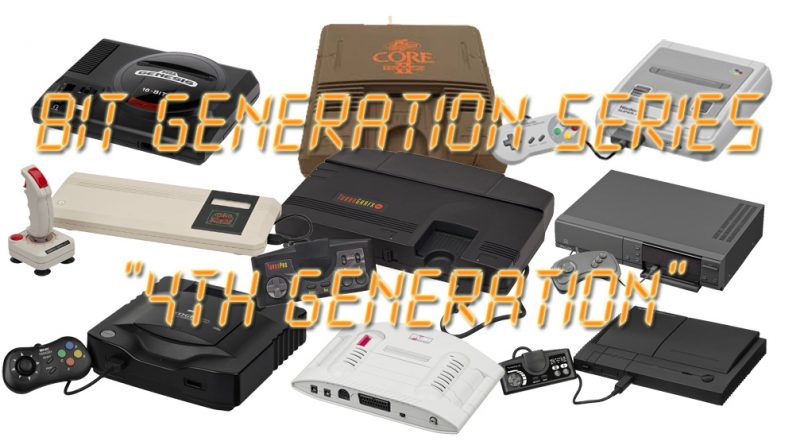











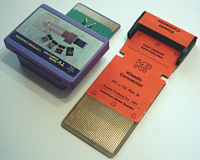
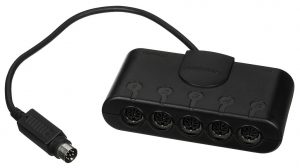


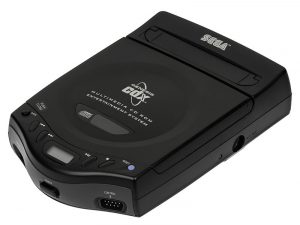



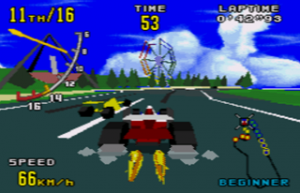
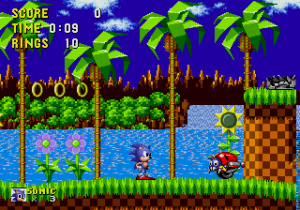

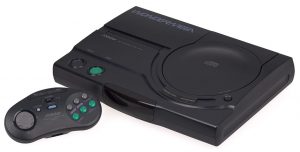










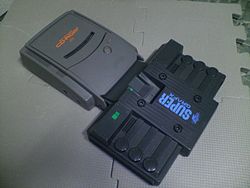


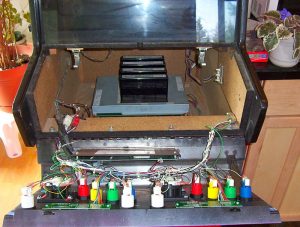
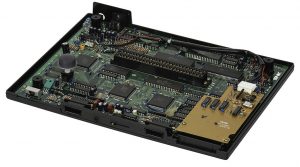

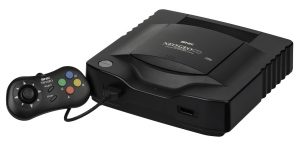
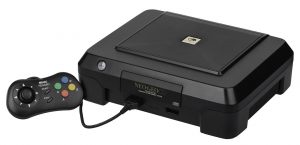
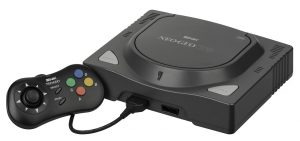
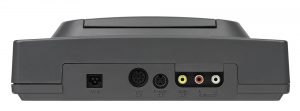


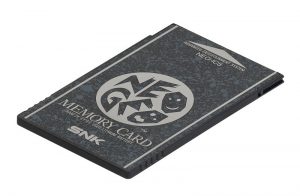




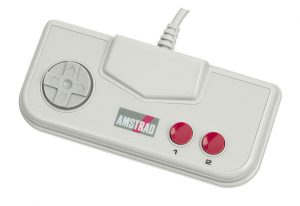


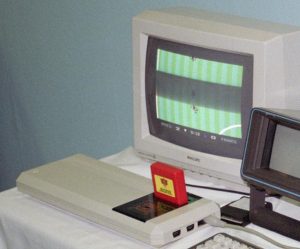























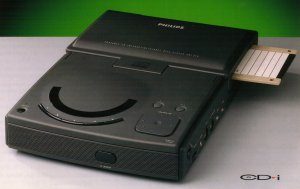
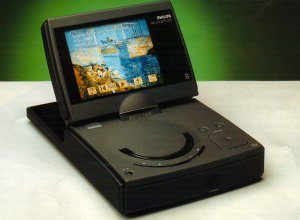




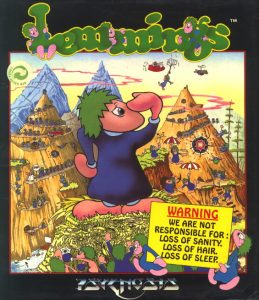




Love this! Nice work!